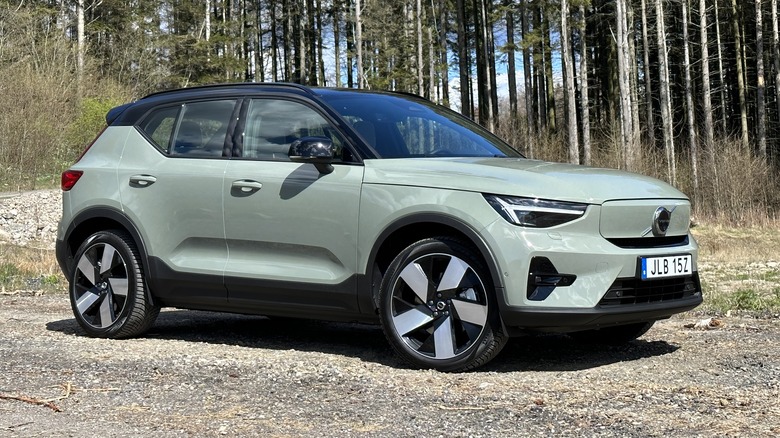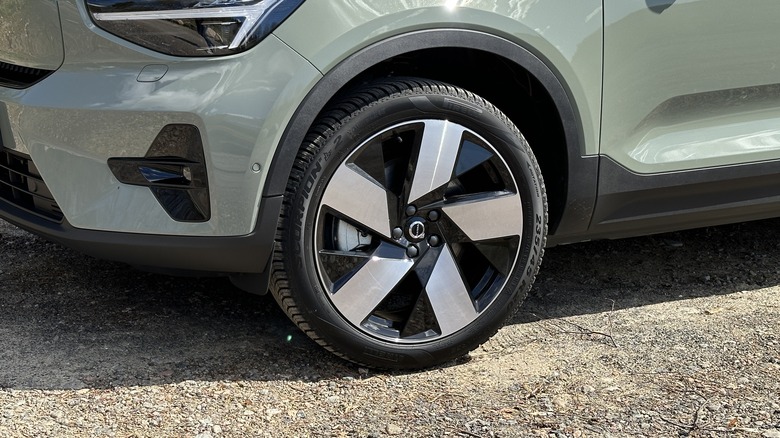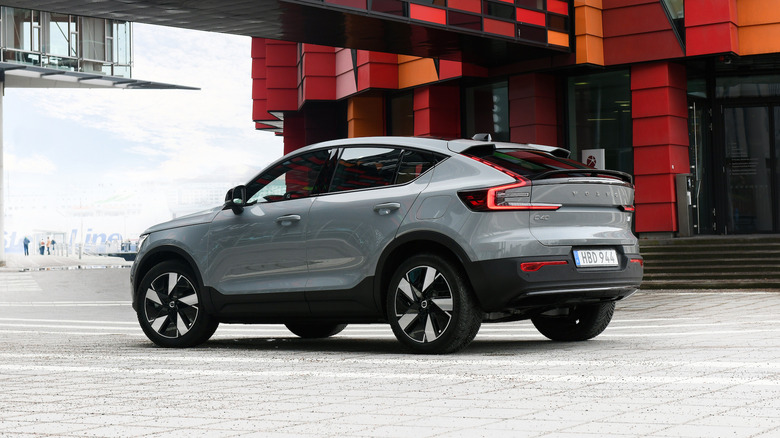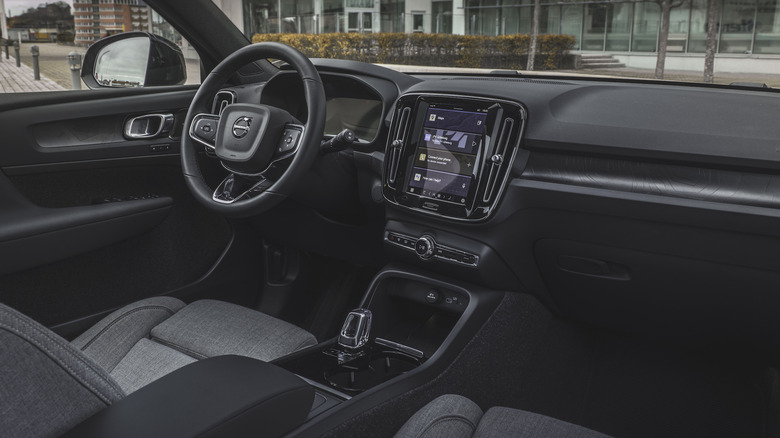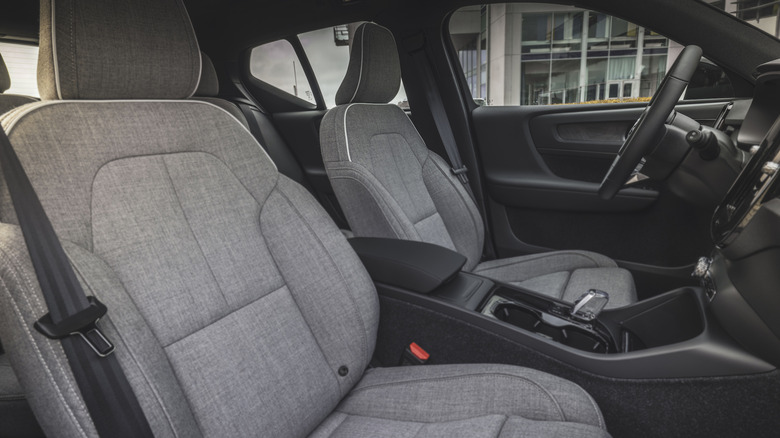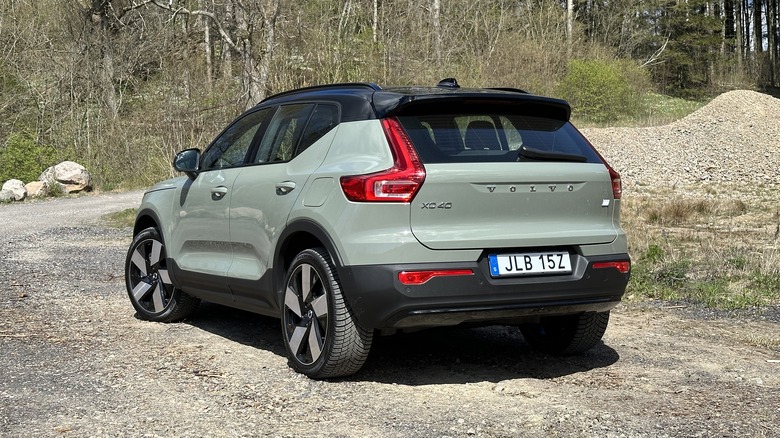2024 Volvo C40 & XC40 Recharge RWD First Drive: Better Off Single
Volvo now offers single-motor versions of its cute little C40 Recharge and XC40 Recharge electric crossovers, adding what's another option for those who like their EVs swift and Scandinavian. And, after driving both around the carmaker's hometown of Gothenburg, Sweden, I'm here to tell you that while two motors have their charms, this less-powerful setup is definitely the way to go.
As before, the XC40 Recharge looks like a compact crossover we're all familiar with at this stage. Launched in late 2021, the C40 Recharge is about the same, right up until you reach the rear doors. Then, Volvo's design follows the four-door-coupe approach that has been increasingly popular, with a dramatic sweep down into a redesigned trunk. You sacrifice some practicality along the way, of course.
What the single-motor Volvos lose in outright power and acceleration compared to their dual-motor variants, they more than make up for with improved on-road manners and –- crucially –- longer driving range and faster charging speeds. These single-motor models will likely be less expensive than the all-wheel-drive versions, as well. Talk about a win-win.
Bigger battery and a new electric drive motor
For the single-motor C40 Recharge and XC40 Recharge, Volvo created a larger 82 kilowatt-hour battery pack, 79 kWh of which is usable. Power is sent to a new electric drive motor that Volvo designed in-house, and here it's mounted on the rear axle, making 248 horsepower and 310 pound-feet of torque. Volvo estimates that both crossovers can accelerate to 60 mph in just under 7 seconds, but the cars genuinely feel quicker than that when you floor 'em. Instant electric torque will do that, after all.
Volvo will continue to offer dual-motor versions of the C40 and XC40, but they still use the older, 78 kWh battery. These cars do get Volvo's new rear axle drive unit, but it's paired with an asynchronous motor that powers the front wheels, and can be electronically decoupled when four-wheel thrust isn't required.
Total output for the all-wheel drive crossovers is 402 hp and 494 lb-ft of torque, which is a heck of a lot. The dual-motor crossovers can really scoot, too, with Volvo estimating a 0-to-60-mph time of 4.6 seconds for the XC40 and 4.5 seconds for the ever-so-slightly more aerodynamic C40.
Does the performance loss matter?
So, the new single-motor cars are a little slower, but I'm not sure — for most of the target audience — that really matters.. Sure, the dual-motor models are quick, but you don't miss the extra power in the single-motor variants. Besides, consider the actual use cases for a C40 Recharge or XC40 Recharge. These are city runabouts: daily drivers. Outright speed is not a priority for this type of vehicle, and should you need to quickly dart around slow traffic, immediate torque delivery will always have your back.
That said, the rear-wheel-drive setup does give Volvo's small EVs a bit of a handling boost. Not only are these crossovers about 200 pounds lighter than their dual-motor counterparts, since there's no torque being delivered to the front wheels, there's less of a tendency to understeer if you're accelerating through a corner. There's no torque steer if you nail it in a straight line, either.
Some people will be quick to point out that an all-wheel-drive setup has benefits for foul-weather prowess, and that even front-wheel drive might be a better choice for slogging through slush and snow. But Volvo says the rear-drive configuration actually results in better overall balance and genuinely makes driving an electric car safer in inclement weather. And don't forget: Volvo's headquarters is in Gothenburg. The Swedes surely know a thing or two about driving on ice and snow.
Faster charging and more range
Arguably the strongest selling points for the single-motor models are their improvements in range and charging speeds, which remain two big hurdles potential EV-shoppers still get hung up on. Volvo estimates the rear-wheel-drive C40 Recharge can go 297 miles on a full charge, with the XC40 Recharge falling just shy of that, at 293 miles. The dual-motor SUVs? Volvo says a C40 will go 257 miles and the XC40 will cover 254 miles. These aren't massive discrepancies between the single- and dual-motor variants, but with electric driving range, every mile counts.
When it comes time to plug in, all versions of the C40 Recharge and XC40 Recharge can accept DC fast charging, but the newer, bigger battery pack in the single-motor cars can replenish at a higher rate. The dual-motor models are limited to the same 150 kilowatt max charging speed as before, but the rear-drive EVs can do 200 kW. That means, in ideal conditions, a single-motor Volvo can go from a 10% to 80% state of charge in less than a half hour. A 50-kW speed boost is a solid improvement, and brings the C40 Recharge and XC40 Recharge roughly in line with their Polestar 2 cousin.
C40 or XC40?
Aside from the mechanical changes, the 2024 C40 Recharge and XC40 Recharge aren't all that different than before. There are a couple of fresh colors, as well as spiffy new 19-inch wheel designs. Inside, the cars can be optioned with handsome wool upholstery, and the 9-inch infotainment display runs Volvo's updated Google-powered infotainment tech, with wired Apple CarPlay finally supported. If you like your EV cabins to be avant-garde you may be disappointed, but Volvo knows how to make a clean, stylish interior, and these smaller SUVs are no exception.
Both of these compact EVs are compelling, but I'm totally on team XC40. Looks are subjective, but I'm personally not a fan of the C40's rear-end styling: the aero roof arches and little spoiler are just too much, and take away from the otherwise clean and understated design. The C40 is worse to live with, too, thanks to less rear headroom and a smaller cargo area.
It's harder to see out of, especially through the rear-view mirror which can feel at the wrong height to see through the narrower rear window, and its standard glass roof doesn't have a sunshade and isn't tinted dark enough to keep the sun from frying you on a bright day. Unless you absolutely adore the C40's design, I really can't imagine picking it over the more traditionally shaped (but, to my eyes, every bit as attractive) XC40.
Compelling compact electric SUVs
Aesthetic arguments aside, both of Volvo's compact electric crossovers have oodles of appeal, and the new single-motor configuration only makes them easier to like. Pricing is still to be confirmed — we'll get those numbers closer to the two cars arriving in U.S. dealerships, which Volvo says should be sometime in the second half of 2023 — but expect these rear-drive models to undercut their dual-motor siblings, so I'm guessing starting MSRPs around $50,000. Of course, because the C40 Recharge and XC40 Recharge are built at Volvo's plant in Ghent, Belgium, they won't be eligible for the new EV tax credit in the United States. Womp womp.
Still, that doesn't change the fact that these Volvos are solid little electric SUVs with plenty of character. I'd rather have one of these than a Mercedes-Benz EQB, and I actually think I might like the XC40 better than the funky new Genesis GV60, too. Nothing about the new single-motor setup detracts from this already great package, either. If anything, it's another reminder that sometimes, less really is more.
